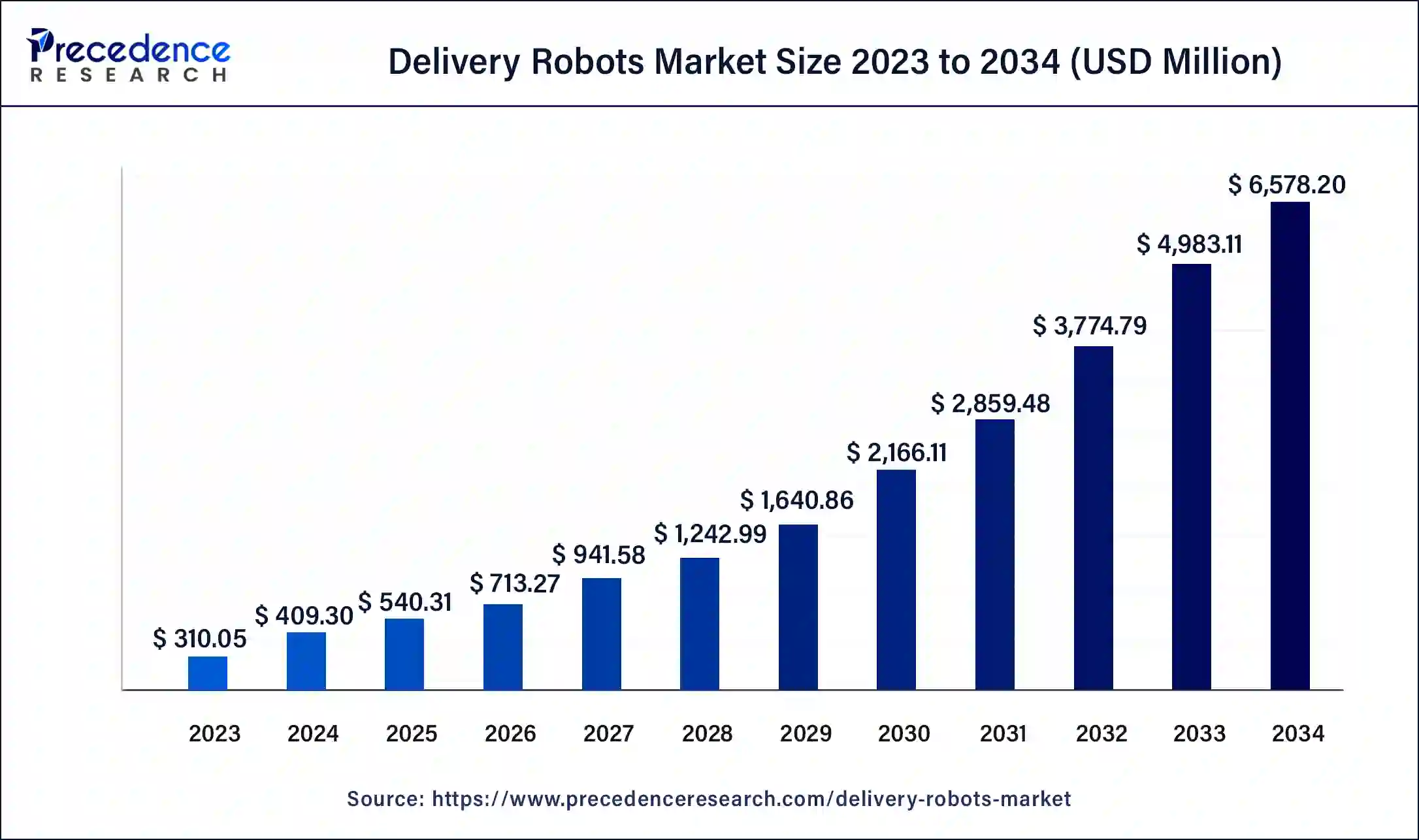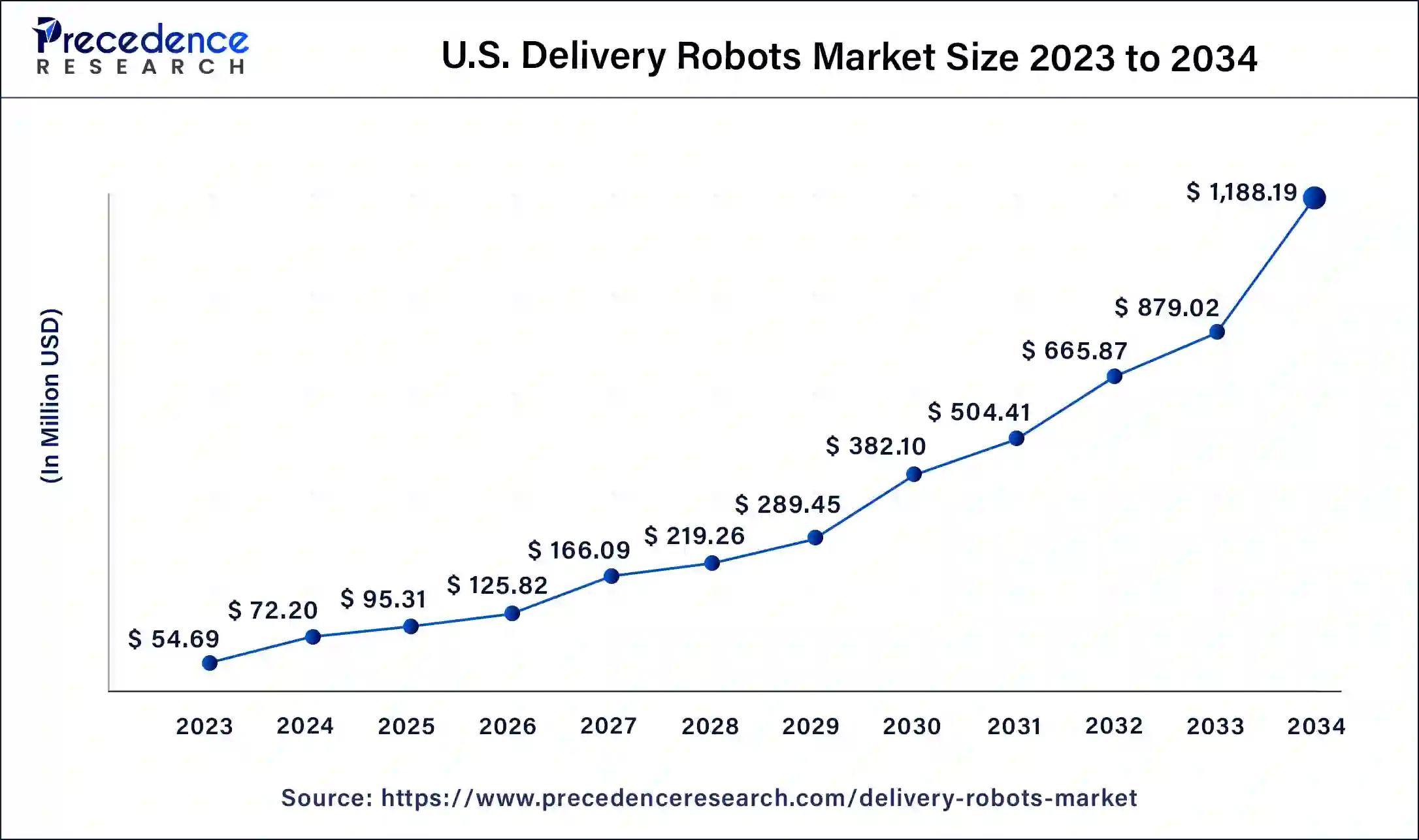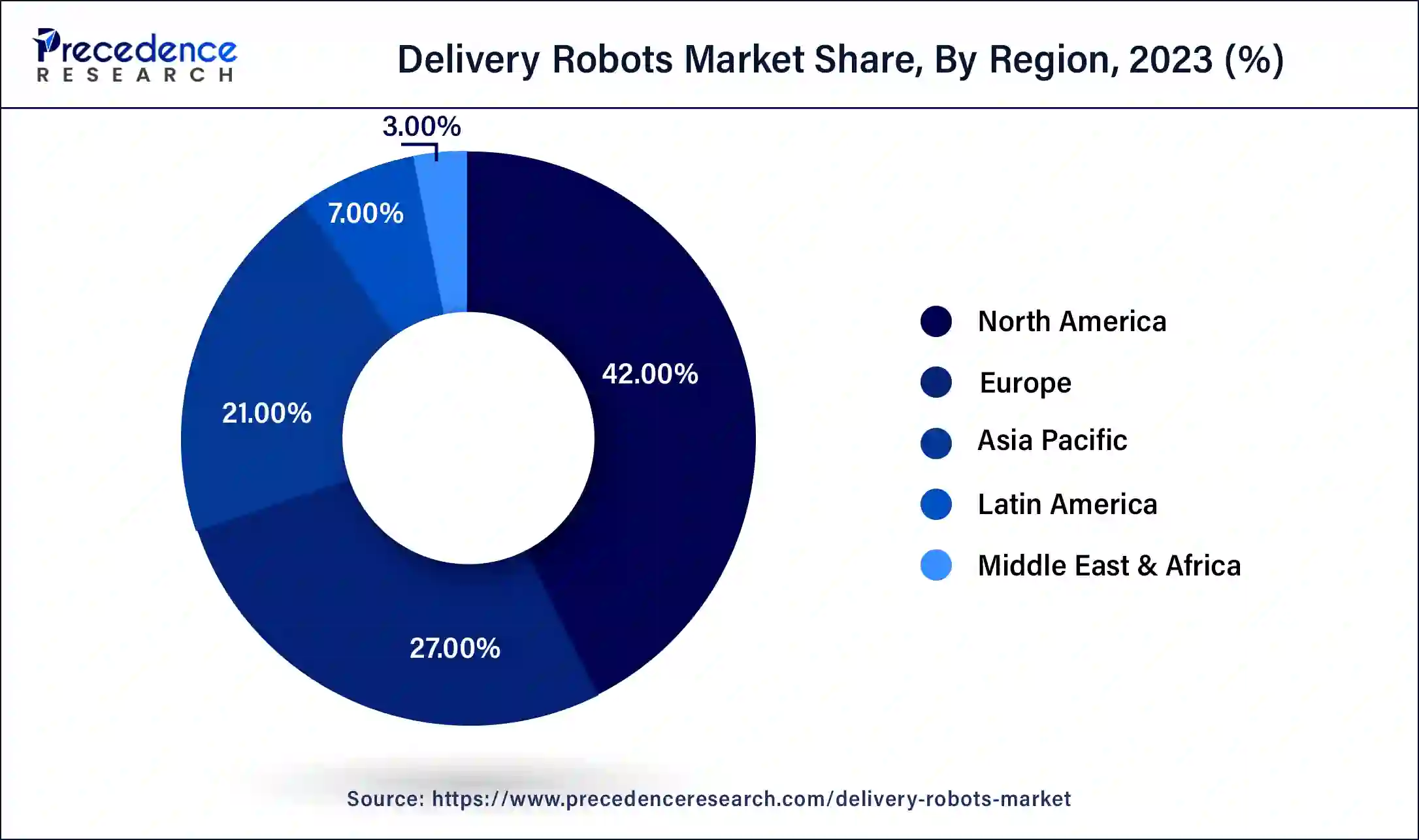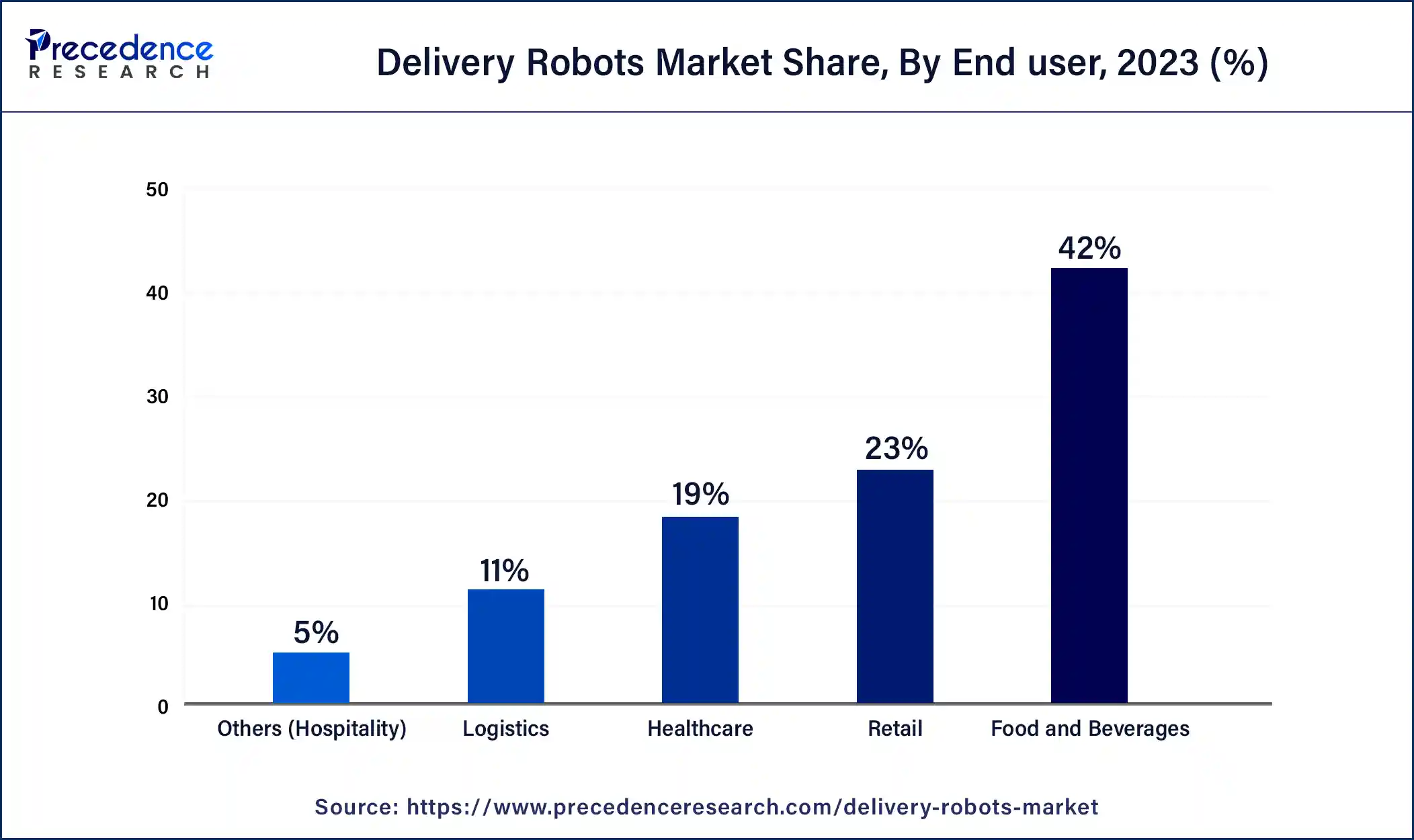List of Contents
Delivery Robots Market Size and Forecast 2025 to 2034
The global delivery robots market size is projected to be worth around USD 6,578.20 million by 2034 from USD 409.30 million in 2024, at a CAGR of 32.01% from 2025 to 2034. The North America delivery robots market size reached USD 130.22 million in 2023. Labor shortages, the efficiency of the autonomous robots and rise in the global e-commerce industry are some of the factors contributing to the growth of the delivery robots market.

Delivery Robots Market Key Takeaways
- The global delivery robots market was valued at USD 409.30 million in 2024.
- It is projected to reach USD 6,578.20 million by 2034.
- The market is expected to grow at a CAGR of 32.01% from 2025 to 2034.
- North America dominated the delivery robots market with the largest market share of 42% in 2024.
- Asia Pacific is expected to host the fastest-growing market during the forecast period between 2025 and 2034.
- By type, the outdoor segment dominated the market in 2024.
- By type, the indoor segment is expected to grow at the fastest rate in the market for the forecast period of 2025 to 2034.
- By load carrying capacity, the 11 kg to 50 kg segment made up the largest share of the market in 2024.
- By load carrying capacity, the up to 10 kg segment is expected to grow at the fastest rate in the market for the forecast period of 2025 to 2034.
- By the number of wheels, the 4-wheel segment dominated the market in 2024.
- By number of wheels, the 6-wheeler segment is expected to grow at the fastest rate in the market for the forecast period of 2025 to 2034.
- By end user, the food & beverage segment has generated the biggest market share of 42% in 2024.
- By end user, the retail segment is set to be the fastest growing of the market for the forecast period.
U.S. Delivery Robots Market Size and Growth 2025 to 2034
The U.S. delivery robots market size was exhibited at USD 54.69 million in 2023 and is projected to be worth around USD 1,188.19 million by 2034, poised to grow at a CAGR of 32.29% from 2025 to 2034.

North America dominated the delivery robots market in 2023. Ongoing research and development efforts in the region and, advances in robotics and artificial intelligence, labor shortages, and the presence of a robust IT infrastructure in the region have led to high demand in the delivery robots market. The presence of several robotics manufacturing firms in the region has also led to significant demand. The American economy also went through the Great Resignation (also known as the Big Quit), where hordes of employees voluntarily quit their jobs starting in early 2021 during the pandemic. The United States has seen a significant drop in labor activity rates since 2010. These factors have contributed to growth in the region's delivery robots market.

Asia Pacific is expected to host the fastest-growing delivery robots market during the forecast period between 2024 and 2033. Rapid rates of urbanization and changing consumer demographics have led to significant growth in the e-commerce sector. Rising internet penetration and the growing number of food delivery apps across Asian countries like Japan, India, South Korea, and China have spurred growth in the region's delivery robots market.
- In 2023, the Korean government amended its existing Intelligent Robots Development and Distribution Promotion Act to allow self-driving delivery robots to operate in outdoor environments. The amendment outlined safety standards for robots operating in public places for both delivery and patrolling solutions.
Japan allowed self-driving delivery robots to mitigate issues caused by labor shortages stemming from an aging population in recent years. The country relaxed its traffic laws to allow these autonomous delivery robots to operate on the streets and sidewalks. Along with changing population demographics, new rules limiting overtime for truck drivers have also impacted supply chains in the country, leaving businesses unable to keep up with delivery demands.
Market Overview
Delivery robots are autonomous vehicles that are used for ‘last mile' delivery services. Delivery robots rely on a number of components, including cameras, GPS navigation, and sensors, which guide them around their routes and avoid collisions with people, obstacles, and cars. These machines use complex locomotion, perception, navigation, and cognition systems to function. The robots make decisions based on algorithms and use artificial intelligence in tandem with their hardware to perform delivery tasks. These machines can either be completely autonomous, or a human operator may take over the controls remotely to guide the robot through certain situations. The delivery robots market paroducts are widely used in industries such as food, grocery, and package delivery, as well as in hospitals and hotels.
Impact of AI on the Delivery Robots Market
Global labor shortages, especially after the pandemic and technological breakthroughs in artificial intelligence and robotics, have significantly spurred demand for delivery robots in the market. However, as the adoption of delivery robots increases, safety concerns and stricter government regulations around their operation are posing a challenge to growth in the market. As AI gets more advanced, the decision-making abilities of these robots get better, presenting opportunities for growth in the delivery robots market.
Delivery Robots Market Growth Factors
- Global labor shortages have encouraged supply chain companies and food delivery apps to turn to self-driving robots to carry out deliveries.
- Technological advancements in robotics and artificial intelligence have spurred growth in the delivery robots market.
- Unique characteristics of delivery robots, including cost-efficiency and continuity of service, have led to widespread adoption of the delivery robots market across the world.
Lasting Impact of the COVID-19 Pandemic on the Delivery Robots Market
During the COVID-19 pandemic, when social distancing practices became the norm, delivery robots saw a surge in interest and demand, pushing autonomous delivery robot developers to start large-scale operations in several U.S. cities for enhanced worker safety. Companies such as Amazon and FedEx started operating delivery robots such as Scout and Roxo, respectively, in California, Texas, and Washington in the United States. Meanwhile, in Asia, Alibaba has adopted delivery robots on a wider scale. The Chinese multinational has used their robot Xiaomanlv to make millions of parcels. Major businesses in the e-commerce space continued funding and adopting last-mile delivery robots even after the end of the pandemic.
- In February 2024, Starship Technologies, a delivery robot manufacturer, raised $90 million in new funding, co-led by Plural and Iconical. This new round of funding brings the total amount raised by Starship to US$ 230 million since the company started in 2014. The latest funding venture was aimed at helping the firm expand globally. Starship has made over six million deliveries, from takeaway orders to groceries, using its delivery robots.
Market Scope
| Report Coverage | Details |
| Market Size by 2034 | USD 6,578.20 Million |
| Market Size in 2023 | USD 310.05 Million |
| Market Size in 2024 | USD 409.30 Million |
| Market Growth Rate from 2025 to 2034 | CAGR of 32.01% |
| Largest Market | North America |
| Base Year | 2023 |
| Forecast Period | 2025 to 2034 |
| Segments Covered | Type, Load-Carrying Capacity, Number of Wheels, End-user, and Regions |
| Regions Covered | North America, Europe, Asia-Pacific, Latin America, and Middle East & Africa |
Market Dynamics
Drivers
Global labor shortages
A growing labor shortage globally has been a driving force behind the adoption of delivery robots. Aging populations in regions such as Europe and Asia, as well as mental health challenges, have led to a decrease in the core workforce. An aging population is leading to a number of job vacancies, with countries like Germany, Spain, Italy, the U.S., Japan, Australia, and Canada struggling to fill positions.
According to the United Nations, fertility rates in over 75 countries are well below the desired replacement rate of 2.1. Eurostat estimates indicate that the European Union could see its population shrink by 27.3 million people (6%) by 2100.
Job vacancy rates have increased globally in the past decade. This trend has continued after the pandemic and continued to stay high. High vacancy rates are causing operational issues and a slowdown in revenue generation. High urbanization rates, especially in the Asia-Pacific, are causing delivery issues due to congestion, raising fuel costs. This has led to the adoption of new and efficient automated delivery methods and prompted many supply chain businesses to shift to delivery robots and drones, leading to growth in the delivery robots market.
Advancements in AMRs
Recent technological developments in autonomous mobile robotics are leading to growth in the scalability of delivery robots. The widespread adoption of 5G+, simultaneous localization and mapping, signal processing, LiDAR, edge computing, and machine vision to navigate their environments and perform tasks.
AI-driven optimization through advanced analytics and machine learning is also driving innovations in the space, automating processes and problem-solving capabilities in operations and networks. The implementation of these technologies has led to the growing adoption of autonomous delivery vans, sidewalk pods, and drone pods that help mitigate costs associated with the last mile of package delivery. Additionally, cloud-based monitoring consoles enable operators to take emergency control of the robots at any given point in time.
Restraints
Increasing federal regulations on delivery robots
Local and federal regulations on delivery robots are limiting investment in delivery robotics. In some countries, there are restrictions on the use of fully automated devices in public spaces, necessitating the need for operator intervention. In the US, several states have adopted legislation regulating delivery robots that use sidewalks. According to data from the Pedestrian and Bicycle Information Center and Supply Chain Dive research, over 23 states currently have some type of rules around how delivery robots can transport goods. These regulations have created apprehension among tech developers, leading them to take a more cautious approach to the widespread use of delivery robots rather than risking public or government backlash.
There is also skepticism among potential users of delivery robots due to limited experience and a lack of confidence in the developing technology. There is an iverse relationship between age with willingness to pay, suggesting that older generations were less comfortable with the integration of this technology.
- According to a 2020 study by researchers at the University of Memphis and Portland State University, 38.7% of consumers surveyed showed zero willingness to pay for package conveyance using delivery robots, citing satisfaction with existing delivery methods.
Opportunities
Upcoming technological advancements in delivery robotics
As autonomous robots become more sophisticated, delivery robots are expected to become safer and more self-reliant, further reducing the need for human intervention. As more businesses adopt Internet of Things connectivity, delivery robots will be able to conduct advanced communications with other devices and systems, further enhancing coordination and overall efficiency. Advanced IoT connectivity will also lead to the collection of real-time data and further enhancement of simultaneous localization and mapping capabilities. This will help future delivery robots respond to environmental changes quicker, inform better decision-making, and enhance collaboration with other systems.
As delivery robots become mainstream, a large number of industries are expected to adopt the technology, leading to the provision of faster, more efficient, and cost-effective delivery services. Investing in research and development of technologies such as non-contact touch and non-LiDAR-based sensors, as well as wireless charging for robotics, will open up several opportunities for businesses in the delivery robots market.
- In 2024, researchers at Qingdao University in China developed a new type of sensor for robotics and other bionic applications that works without direct contact between objects and the sensor at up to 10 centimeters from the object.
Type Insights
The outdoor segment dominated the delivery robots market in 2023. Outdoor delivery robots are used for deliveries of food and beverage and parcels in urban areas, including apartment complexes, offices, and hotels. A number of partnerships between universities, food and grocery delivery apps, and delivery robot manufacturers have led to substantial growth in the outdoor segment. In the United States, George Mason University collaborated with Starship Technologies for on-demand food delivery services across campus. Similarly, Grubhub partnered with Yandex and Uber Eats to set up multiple partnerships with Serve Robotics, Motional, and Cartken for food delivery across several cities.
- In March 2024, Uber Eats Japan started using Cartken delivery robots in Tokyo's Nihonbashi area. The collaboration is currently services two eateries; Tonkatsu Aoki and Benihana Annex with the company expecting to extend the service to more restaurants in the Tokyo area.
The indoor segment is expected to grow at the fastest rate in the delivery robots market for the forecast period of 2025 to 2034. Indoor delivery robots are used for delivering small goods within organizations, including hospitals, hotels, offices, and other high-rise buildings. Indoor delivery robots are being increasingly adopted in settings such as hospitals to reduce the logistics workload on healthcare professionals. Some companies offer robots with code and biometric fingerprint scanners to prevent unauthorized access to contents housed inside the robot. There is currently a severe shortage of healthcare professionals, especially nurses, in countries like the United Kingdom and the United States. Delivery robots deployed in hospitals help reduce the workload for nurses, pharmacy technicians, and runners and reduce operational costs.
- In 2019, more than 150 hospitals in the United States were utilizing delivery robots to deliver food, medical samples, and medical waste.
The World Health Organization estimates a shortage of 4.5 million nurses by 2030. Along with a shortage of professionals, according to a 2024 survey published in the NPJ Mental Health Research journal, 68.7% of nurses reported moderate burnout.
- In 2023, the Milton Keynes University Hospital NHS Foundation Trust collaborated with the UK-based Academy of Robotics to deploy two ‘Milton' robots. According to the company, the two robots make approximately 1,800 deliveries every month, saving hospital staff over 2 million steps across the facility.
Load-carrying Capacity Insights
The 11 kg to 50 kg segment made up the largest share of the delivery robots market in 2023. The carrying capacity of robots in this segment lends them increased versatility. Robots in this segment are widely used for package delivery, in warehouses and logistics centers for transporting products.
The up to 10 kg segment is expected to grow at the fastest rate in the delivery robots market for the forecast period of 2025 to 2034. These robots are widely being adopted for deliveries of smaller packages in urban spaces. Their small size makes them a good fit for most sidewalks.
Number of Wheels Insights
The 4-wheel segment dominated the delivery robots market in 2023. Robots in this segment have features such as zero radius turning, making them more efficient, especially when equipped with sensors and 360-degree vision cameras. Four-wheel robot models are also cost-effective compared to other larger robots, allowing for wider adoption among small and medium-sized firms looking to integrate delivery robot fleets into their supply chain.
The 6-wheeler segment is expected to grow at the fastest rate in the delivery robots market for the forecast period of 2025 to 2034. Six-wheel robots provide improved stability and are able to traverse a variety of terrains. The extra wheels also allow for superior maneuverability compared to lesser-wheeled versions. Companies such as Starship and Amazon in the sector are increasingly adopting six-wheel robots, especially for congested urban landscapes.
End user insights
The food & beverage segment made up the largest share of the delivery robots market in 2023. Food delivery apps are pilot-testing robot delivery options globally to combat labor shortages, especially in the European Union, the United States, and Asian countries such as Japan.
- In August 2024, South Korea-based delivery app Baedal Minjok announced that it would use the ‘Dilly' robot in Seoul and surrounding metropolitan cities to conduct food deliveries this year. The creator of Dilly, Woowa Brothers, obtained safety certification for its use from the Korea Institute for Robot Industry Advancement.

The retail segment is set to be the fastest growing of the delivery robots market for the forecast period. Several large e-commerce platforms, including Amazon and Alibaba, are increasingly pilot-testing delivery robots to carry out B2B2C deliveries.
- In May 2024, Finland's S Group planned an expansion of their robot fleet to cover more than 100 stores by the end of the year. S Group collaborated with Starship and has carried out over 150,000 deliveries using their fleet of self-driving electric robots. The company carried out a pilot project in the Helsinki metropolitan area two years ago and expanded the project to over 50 stores across the country by 2023.
Recent Developments
- In February 2024, Uber Eats collaborated with Mitsubishi Electric and Cartken to debut the 'Model C' robot in Japan to conduct food deliveries. The Model C is being used to carry out deliveries in the Tokyo area, traveling at speeds up to 3.4 mph. The robot uses AI models to detect objects and obstacles and localization algorithms to navigate the cityscape.
- In February 2024, Starship Technologies announced it had raised €83.6 million, co-led by Plural and Iconical, for the continued development of its delivery robots. With this new round of funding, the Tallinn-based firm has raised a total of €213.7 million since its creation in 2014.
Delivery Robots Markets Top 14 Companies
- Alibaba Group Holding Ltd.
- Amazon, Inc.
- Drone Delivery Canada Corp.
- Flytrex Inc.
- JD.com, Inc.
- Kiwi Campus (Kiwibot)
- Nuro, Inc.
- Refraction AI
- Shenzhen Yiqing Innovation Technology Co., Ltd. (Unity Drive Innovation)
- Starship Technologies
- TeleRetail
- Udelv Inc.
- Wing Aviation LLC
- A2Z Drone Delivery, LLC
Segments Covered in the Report
By Type
- Indoor
- Outdoor
By Load-Carrying Capacity
- Up to 10 kg
- 11 kg to 50 kg
- More Than 50 kg
By Number of Wheels
- Three Wheels
- Four Wheels
- Six Wheels
By End-user
- Healthcare
- Food & Beverages
- Retail
- Logistics
- Others (Hospitality)
By Geography
- North America
- Asia Pacific
- Europe
- Latin America
- Middle East & Africa
For inquiries regarding discounts, bulk purchases, or customization requests, please contact us at sales@precedenceresearch.com
Frequently Asked Questions
Ask For Sample
No cookie-cutter, only authentic analysis – take the 1st step to become a Precedence Research client